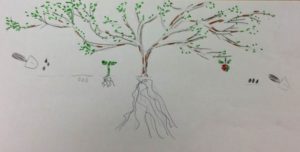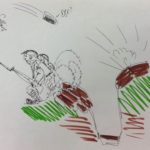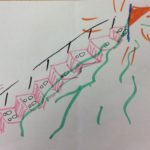In this video Sylvie talks about how she has been changing the delivery of academic skills to develop the the level of integration between generic academic skills and subject specific skills. In addition, she explains the process of integrating blended approaches into CfAP’s (Centre for Achievement and Performance) delivery.
 Having redesigned her Leading Public Health Practice module from being fully face-to-face, to blended, Sue Everett in the School of Health, reflects on the skills she developed in the process and how she has moved from being a ‘technophobe’ to the ‘go to’ girl for technology in her office!
Having redesigned her Leading Public Health Practice module from being fully face-to-face, to blended, Sue Everett in the School of Health, reflects on the skills she developed in the process and how she has moved from being a ‘technophobe’ to the ‘go to’ girl for technology in her office!
If you have any questions about CAIeRO, or would like to book one for your module team, please email LD@northampton.ac.uk. If you would like to talk further to Sue about her experiences, she is happy for you to contact her.
 In March/April 2014, Sue Everett, Kirsty Mason and Stuart Allen in the School of Helath underwent a CAIeRO on their three modules for the PGC in Public Health. Initially redesigned for fully online learning, the Programme was slightly altered to reintroduce some face-to-face sessions, resulting in a ‘Waterside-ready’, set of blended learning modules.
In March/April 2014, Sue Everett, Kirsty Mason and Stuart Allen in the School of Helath underwent a CAIeRO on their three modules for the PGC in Public Health. Initially redesigned for fully online learning, the Programme was slightly altered to reintroduce some face-to-face sessions, resulting in a ‘Waterside-ready’, set of blended learning modules.
Having run her module in the new design, Sue shares some of her reflections on the process and her learning experiences in this video.
If you have any questions about CAIeRO, or would like to book one for your module team, please email LD@northampton.ac.uk. If you would like to talk further to Sue about her experiences, she is happy for you to contact her.
Following my Getting ‘Waterside’ Ready post last week about ways in which the Learning Designers can help academic staff think about how to develop their skills for more blended learning and teaching, I thought it would be useful and fun(!) to share some of the drawings produced by one staff team on what they value in their face-to-face teaching. And I expect that not many of them ever thought they would see their artwork in print!
In light of the fact that it is the 100 year anniversary of Gallipoli, this tutor perceived his teaching in terms of going over the top and everyone being all in it together. No-one was left behind in the trench, but they were heading into no-man’s land and getting stuck in, entering the battle together.
 This image drew on the Greek idea of heaven. The various parts were all created and then everything was thrown up into the air and disrupted, before it all comes back down together as a composite whole.
This image drew on the Greek idea of heaven. The various parts were all created and then everything was thrown up into the air and disrupted, before it all comes back down together as a composite whole.
This image is about inspiration and asking questions, but that we are all on a different journey but will all end up reaching the horizon / sunset.
There are lots of different expressions on the people in this picture, showing apprension, anxiety, excitement, worry … As staff we have to manage so many different things that are going on for our students which is hard, but also exciting.
This picture is of climbing a mountain – there are hard challenges ahead, but our role is to give the students structured support to help them progress and ultimately to achieve their goal.
This image captures the role of the tutor as someone who can provide knowledge, students can find things out for themselves, we offer them support (a strong arm) and time.
As tutors we can generate excitement. This is a modern lightbulb representing new ideas and students bringing their own ideas and capabilities. A new generation of ideas and lots of sparks going off, all around.
 The idea of a teaching cycle is clearly apparent from this visual representation of what is valued in teaching. The notion of planting the seeds and nurturing the young plants as they grow into a mature tree that bears fruit in due time. Sometimes more seeds are needed but always the cycle continues.
The idea of a teaching cycle is clearly apparent from this visual representation of what is valued in teaching. The notion of planting the seeds and nurturing the young plants as they grow into a mature tree that bears fruit in due time. Sometimes more seeds are needed but always the cycle continues.
Mature students can also be anxious about learning, but as they share their experiences this can lead to illumination and qualification.
This tutor conceived of his face-to-fae teaching as including lots of talking in a safe and secure environment where they can flourish and develop themselves. Drama and other physical activities take place both in and out of the classroom and the role of the tutor is to take that step back and watch the students flourish.
The notions about teaching in this image are that of encouraging the students to think differently and independently – they may well end up on a different route to that envisaged by the tutor. Includes the idea of being a rebel.
A number of ideas are expressed here – the notion of signposting students, mountains to climb and holding up a mirror to the students to get them to reflect and learn from themselves and others – they are their own resource.
This final image also captures a variety of concepts. There is the idea of dialogue leading to lightbulb moments both as students among themselves but also in discussions with tutors. They are also the drivers, the ones in control, but it isn’t a ‘journey’ – this tutor wants students to be bothered and to be rebels WITH a cause.
Q: How do you eat an elephant?
A: One bite at a time!
 The move to Waterside can seem as if it isn’t really that long away, given all that you may feel you have to do inbetween now and then. Wondering where to start can also seem daunting and the mountain of work that you see ahead of you can be so huge that you can’t even see the summit, let alone work out a route to the top.
The move to Waterside can seem as if it isn’t really that long away, given all that you may feel you have to do inbetween now and then. Wondering where to start can also seem daunting and the mountain of work that you see ahead of you can be so huge that you can’t even see the summit, let alone work out a route to the top.
In supporting staff to get to grips with the course redesign implications that are predicated on a number of guiding principles about how learning and teaching will look, the Learning Design team came across a really useful set of blog posts by Tony Bates, a Canadian Research Associate who is also President and CEO of Tony Bates Associates Ltd and who, according to their website are “a private company specializing in consultancy and training in the planning and management of e-learning and distance education.”
The blog posts were written to help people understand and implement a series of practical steps to help deliver quality in their online learning materials. While I don’t wish to duplicate the posts here, I thought it might be helpful to summarise some of the key points in an attempt to help you to start thinking about how you might begin to eat your own elephant, or climb that mountain. I found some obvious points in the posts, some practical and straightforward suggestions and some real gems. There are also some questions and exercises to get you started along the road to redesigning your own modules.
I should also preface this post with the reminders that, as an institution, we are definitely NOT going fully online but will be exploring ways to enhance our learning and teaching using technology and that the precise nature of each blended module is for staff teams to determine.
The Nine Steps are as follows (each link will take you straight to the original post)
- Step 1: Decide how you want to teach online
- Step 2: Decide on what kind of online course
- Step 3: Work in a Team
- Step 4: Build on existing resources
- Step 5: Master the technology
- Step 6: Set appropriate learning goals
- Step 7: Design course structure and learning activities
- Step 8: Communicate, communicate, communicate
- Step 9: Evaluate and innovate
Step 1: Decide how you want to teach online
 This step highlights the importance of rethinking the way you teach when you go online and redesigning the teaching to meet the needs of your online learners given that their needs may differ because of the specific learning context. The gem in this post is the emphasis on asking you to consider your basic teaching philosophy – what is your role and how would you like to tackle some of the limitations of classroom teaching and renew your overall approach to teaching? As Bates himself says: “It may not mean doing everything online, but focussing the campus experience on what can only be done on campus.”
This step highlights the importance of rethinking the way you teach when you go online and redesigning the teaching to meet the needs of your online learners given that their needs may differ because of the specific learning context. The gem in this post is the emphasis on asking you to consider your basic teaching philosophy – what is your role and how would you like to tackle some of the limitations of classroom teaching and renew your overall approach to teaching? As Bates himself says: “It may not mean doing everything online, but focussing the campus experience on what can only be done on campus.”
Step 2: Decide on what kind of online course
 Bates describes a continuum of online learning ranging from online classroom aids to fully online and explores four key factors that will influence the kind of online course you should be teaching:
Bates describes a continuum of online learning ranging from online classroom aids to fully online and explores four key factors that will influence the kind of online course you should be teaching:
- your teaching philosophy (see step 1)
- the kind of students you are trying to reach (or will have to teach)
- the requirements of the subject discipline
- the resources available to you
A number of subject groups and disciplines are already starting to explore what the current direction of travel for learning and teaching at Northampton might look like for them and developing models and suggestions for how to redesign their modules and programmes within a broader set of principles. It is useful to note that while Bates experience suggests that “almost anything can be effectively taught online, given enough time and money” (emphasis added), the reality is that resources are finite and that it is therefore imperative to work out what could and should be taught face-to-face and what could and should be taught online, remembering that we are still going to be primarily a campus-based institution. He begins the process by differentiating between the teaching of content and the teaching or development of skills and provides a useful example of how this might look in practice.
The gem here is his consideration of how to make best use of the various resources available to you including time (the most precious resource of all), your learning technology support staff (always glad to help), your VLE (NILE) and your colleagues.
Step 3: Work in a Team
 Online learning is different to classroom teaching and as a result will require staff to learn some new skills. You are unlikely to have all your F2F learning materials in a suitable format for online learning. This post considers how the team of staff around you can help you to move from where you are, to where you want to get to given that “particular attention has to be paid to providing appropriate online activities for students, and to structuring content in ways that facilitate learning in an asynchronous online environment”. Working in a team can also, of course, help with managing the workload, and with getting quickly to a high quality online standard, as well as being a way to save some of your time.
Online learning is different to classroom teaching and as a result will require staff to learn some new skills. You are unlikely to have all your F2F learning materials in a suitable format for online learning. This post considers how the team of staff around you can help you to move from where you are, to where you want to get to given that “particular attention has to be paid to providing appropriate online activities for students, and to structuring content in ways that facilitate learning in an asynchronous online environment”. Working in a team can also, of course, help with managing the workload, and with getting quickly to a high quality online standard, as well as being a way to save some of your time.
Step 4: Build on Existing Resources
As one Deputy Dean said at a recent School Learning and Teaching Development Day: “Let’s not throw the baby out with the bathwater!”
This can include repurposing your own content, but also drawing on existing online resources (TED talks, The Khan Academy, iTunesU) as well as ‘raw’ content that you can use as the basis for developing learning activities and he argues that ‘only in the areas where you have unique, original research that is not yet published, or where you have your own ‘spin’ on content, is it really necessary to create ‘content’ from scratch”.
The hidden gem? Distinguishing between using existing resources that “do not transfer well to an online learning environment (such as a 50 minute recorded lecture), and using materials already specifically developed for online teaching”. He suggests that you “take the time to be properly training in how to use [NILE]”, recognising that a 2-hour investment now can save you hours of time later on.
Step 5: Master the Technology

That’s it really – come to some training on the tools that you would like to use and know more about! This includes learning about their strengths and weaknesses so that you know that you have selected the right tool for the job, but also have a clearer idea about how they might work in practice or how to avoid some of the pitfalls. There are plenty of tools out there, but selecting the right tool is an instructional or pedagogical issue that requires you to be clear on what it is that you are trying to achieve.
Bates’ gem (from my perspective) is his no-nonsense approach to engaging with central training and development initiatives. Here are a few that might help:
- The CLEO (Collaborative Learning Experiences Online) workshop that forms part of our C@N-DO staff development programme is a good way of putting yourself in the shoes of the online learning and experiencing first hand some of the obstacles that online learners face, in order to prevent your own students facing similar issues.
- NILE training (around specific pedagogical purposes) is provided by the Learning Technology team and in addition to regular scheduled training, can also be tailored to suit the purposes of your subject team or discipline. Please just ask!
- Spend a little time each year looking at any of the new features added to NILE during the year (Check out the Learntech Blog for updates).
Finally in this step is a discussion around why simply recording your lectures is not the best way to go. Definitely worth the time to read through his reasons, if this is something you were considering.
Step 6: Set appropriate Learning Goals
 In short, should the learning goals (outcomes) for online/blended learning be the same as, or different to the same module delivered in a fully face-to-face mode? The key differentiator is that while the goals may well remain the same, the method may change. He also raises the question as to whether additional learning outcomes need to be considered in terms of the development of 21st century learning skills (in particular, learning the skills to ‘manage knowledge’ long after they graduate).
In short, should the learning goals (outcomes) for online/blended learning be the same as, or different to the same module delivered in a fully face-to-face mode? The key differentiator is that while the goals may well remain the same, the method may change. He also raises the question as to whether additional learning outcomes need to be considered in terms of the development of 21st century learning skills (in particular, learning the skills to ‘manage knowledge’ long after they graduate).
The link between learning outcomes and assessment is also explored here as is the way in which assessment drives student behaviour. He concludes by saying that “[b]ecause the internet is such a large force in our lives, we need to be sure that we are making the most of its potential in our teaching, even if that means changing somewhat what and how we teach”.
Step 7: Design Course Structure and Learning Activities
After an initial exploration between ‘strong’ and ‘loose’ online learning structures, Bates identifies the three main determinates of teaching structure as being:
- the organisational requirements of the institution;
- the preferred philosophy of teaching of the instructor; and
- the instructor’s perception of the needs of the students.
In the light of recent discussions here around what is meant by ‘contact’ hours (see this Definitions paper produced recently by the University’s Institute of Learning and Teaching), he identifies problems with this approach whilst simultaneously recognising that this is, nevertheless, the standard measuring unit for face-to-face teaching. One reason he highlights in particular is that it measures input, not output. Bates is also keen to ensure parity between online and face-to-face learning in terms of ensuring quality at Validation.
He discusses the time input as well as the structure of modules and how existing face-to-face structures mean we can already be some way down the path on module design, with the important proviso that it is important to ensure that content moved online is suitable for online learning. This is where the Learning Design team can help you to make decisions around what to teach or what to leave out, given that making some work optional means it should not be assessed and that if it is not assessed, students will quickly learn to avoid doing it.
This step concludes with a look at how to design student activities. This is typically something that would be covered during the second day of a CAIeRO curriculum redesign workshop, but anyone who has participated in any part of the C@N-DO programme will already have come into contact with some of these online learning activities / e-tivities. Some good points for consideration here though.
Step 8: Communicate, communicate, communicate
 This steps explores the vital importance of ongoing, continuing communication between the tutor and the online learners, that is more than simply seeing them in class on a weekly basis. Maintaining tutor presence in the online environment is a “critical factor for online student success and satisfaction”, helping students recognise that their online contributions are just as much a part of their learning experience as the face-to-face components.
This steps explores the vital importance of ongoing, continuing communication between the tutor and the online learners, that is more than simply seeing them in class on a weekly basis. Maintaining tutor presence in the online environment is a “critical factor for online student success and satisfaction”, helping students recognise that their online contributions are just as much a part of their learning experience as the face-to-face components.
Creating a compelling online learning environment is possible but requires deliberate planning and conscientious design. It must also be done in such a way as to control the instructor’s workload. Bates has a number of ‘top tips’ for setting and managing student expectations online and emphasises that tutors should also adhere to these themselves. Like in the CLEO, he suggests starting with a small task in the first week that enables the guidelines to be applied, with the tutor paying particular attention to this activity. As he rightly points out …
students who do not respond to set activities in the first week are at high risk of non-completion. I always follow up with a phone call or e-mail to non-respondents in this first week, and ensure that each student is following the guidelines … What I’m doing is making my presence felt. Students know that I am following what they do from the outset.
There is a discussion here around the benefits and disadvantages of both synchronous and asynchronous communication – the decision again being based on pedagogical need. There is also a list of tips for how to manage online discussions for you to read an inwardly digest 🙂 and a consideration of how cultural factors can impact on participation.
Step 9: Evaluate and Innovate
 We ask our students to do it all the time – let’s make sure we apply the same principles to our own learning and teaching development and complete our own reflective cycle. Bates has a series of questions to guide any evaluation of teaching (not just online teaching), linking it back to Step 1 where he defines what we mean in terms of ‘quality’ in online learning. This doesn’t have to be a hugely onerous task – we already have ways of answering some of the questions (e.g. student grades, student participation rates in online activities (track number of views), assignments, Evasys questionnaires etc).
We ask our students to do it all the time – let’s make sure we apply the same principles to our own learning and teaching development and complete our own reflective cycle. Bates has a series of questions to guide any evaluation of teaching (not just online teaching), linking it back to Step 1 where he defines what we mean in terms of ‘quality’ in online learning. This doesn’t have to be a hugely onerous task – we already have ways of answering some of the questions (e.g. student grades, student participation rates in online activities (track number of views), assignments, Evasys questionnaires etc).
Then consider what it is that you need to do differently next time, in this ongoing, iterative process of Quality Enhancement.
Hopefully you will have the opportunity to explore some of these blog postings as you begin to think about how to get ready for Waterside, even if you don’t agree with everything that Bates says!
Our colleagues at CfAP are often on the receiving end of poor assessment design. In this post, Kate Coulson, Head of CfAP, describes the impact on the student experience and looks at ways to ensure this won’t happen to your students…
“Maya* is an undergraduate in the second year of her degree. Throughout her first year, she was averaging a C grade in her assessments. Maya has just received her grade and feedback from her first assessment of her second year. She was given a D grade and the marking tutor advised her to visit CfAP to get some support and guidance in “understanding the question”.
When Maya meets with a CfAP Tutor she becomes very distressed and states that “the question didn’t make sense” and “I don’t know what I needed to include”. She also states that she spoke to her tutor directly as she was unclear about the assessment but their conversation left her more confused. When chatting to her course mates about the assessment, they had interpreted the requirements in a totally different way and she panicked and didn’t know what to do.”
When writing questions for essays or assignments it is imperative that you think about the student. Badly written essay questions confuse the student and can affect their confidence and performance in the task – sometimes even leading them to question whether University is the right place for them.
Tips to help you avoid the pitfalls:
- Allow time to plan your questions or tasks.
- Be clear about what knowledge and skills you want the students to demonstrate (these should be informed by your learning outcomes).
- When you are writing a question or task, consider the stage of the programme and module where it takes place, and evaluate whether the students have the content knowledge and the skills necessary to respond adequately.
- When scheduling, be aware of other assessments students will be given from other modules on the programme. Nobody benefits from students having to divide their time and energy between multiple deadlines.
- Discuss the assessment with your students – both the task itself and the purpose of it. Explaining why you have chosen this task, and how it will help them to reach the learning outcomes, will help them feel ownership. Be prepared to adjust in response to valid feedback.
- Share grading criteria and rubrics ahead of the assessment. Students should know what they are aiming for, and what satisfactory performance looks like. Better still, consider writing a model answer. This will help you to reflect on the clarity of the essay question, even if you choose not to share it with the students until after the deadline. It could also serve to inform the grading of students’ responses.
- Use your colleagues to critically review the question or task, the model answer and the intended learning outcomes for alignment.
- Use formative tasks to help students to develop their understanding of expectations and standards. Better still, plan out the ‘assessment journey’ when planning your module, to ensure students have opportunities to learn the process as well as the content of the assessment. The Assessment and Feedback cards from the JISC Viewpoints project can help you do this.
Writing good essay questions is a process that requires time and practice. Review your questions after the students have completed them, think about how the questions have been interpreted. Studying the student responses can help evaluate students’ understanding and the effectiveness of the question for next time.
Useful reading and resources:
The University’s Assessment and Feedback Portal provides more information about assessment design, including links to published research in this area.
The Assessment Brief Design project from Oxford Brookes gives detailed guidance on writing clear and targeted briefs.
For more on the great work done by the Centre for Achievement and Performance, visit the CfAP tab on NILE.
*”Maya” is a fictional character, although her story is based on real events.
A number of staff are designing e-tivities (online learning activities) that require students to undertake some independent research and then share a link to the online resource with peers who can then click on the link and view the article for themselves.
If the article has been found and accessed through NELSON and the link shared with students who are not already authenticated through the University systems then they will be faced with either a dead link or an ‘Access Denied’ message.
In this situation the solution is as follows:
- Ask students to include the full reference for the journal so that potential viewers can access the article themselves via the Library ‘Find My Reference’ tool. By using this route, students will be prompted to login with their University login in order to get access to the article.
If this applies to you, please change your e-tivity instructions to ask for articles to be shared using the University of Northampton Harvard referencing style. Include this link to a Skills Hub video that shows quickly how to use the ‘Find My Reference’ tool. You might also want to include an example of how to reference a journal using the Harvard journal – guidance is available from the Help Tab in NILE.
The added bonus for the students, of course, is practice in Harvard referencing!
With thanks to Hannah Rose, Academic Librarian for helping us with the solution
 On Monday 10th November, Learning Technology and the Institute of Learning and Teaching will be co-facilitating a full-day workshop on Team-Based Learning with TBL pioneer Larry Michaelsen.
On Monday 10th November, Learning Technology and the Institute of Learning and Teaching will be co-facilitating a full-day workshop on Team-Based Learning with TBL pioneer Larry Michaelsen.
This is an opportunity to experiment with an effective, structured and learner-centred approach to teaching on-campus modules where students work effectively in groups. A combination of individual work, group work and feedback is used to create a motivational framework in which learners increasingly hold each other accountable for coming to class prepared (yes really!) and contributing to discussion.
If you want to learn how to use your class time for more than simply covering content, and focus instead on providing students with opportunities to apply their learning of core course concepts to solve problems, then this workshop is for you.
To find out more about TBL, please watch this short-ish (12 minute) video to find out more about Team-Based Learning or read this short overview.
There are only 54 places available, so book your place today.
- Monday 10th November
- Grand Hall, Newton Building, Avenue Campus
- Refreshments and lunch provided
 Personally I love the CAIeRO (module redesign) process. It’s creative, innovative and definitely challenging at times, but most of all it’s fun. My favourite part of the day is storyboarding the module – aligning Learning Outcomes with (new) assessments and then looking at how learners are to engage with appropriate content in order to deepen their learning and apply their knowledge and understanding.
Personally I love the CAIeRO (module redesign) process. It’s creative, innovative and definitely challenging at times, but most of all it’s fun. My favourite part of the day is storyboarding the module – aligning Learning Outcomes with (new) assessments and then looking at how learners are to engage with appropriate content in order to deepen their learning and apply their knowledge and understanding.
Having an ‘outsider’ to your module can be crucial to the level of creativity and innovation that results. As a former FE tutor, and AL for the Business School I have experienced first hand many of the difficulties of trying to deliver engaging content and being so focussed on ensuring that the core content is covered that I couldn’t see the wood for the trees. Being able to take a step back and view what you are doing from an outsiders perspective, often that of a fictional learner, can therefore bring a number of benefits.
 As an example, I was involved in a recent CAIeRO with the School of Health, working on three modules to be delivered fully online. We reached the storyboard phase and the tutor and I were looking at what the module was covering and thinking about how to translate a face-to-face course into an online one. To begin with, the tutor was replicating his F2F module, whilst simultaneously regaling me with stories of student feedback and complaints. “Why am I studying statistics?” and “Why am I studying maths on a health course?!” were two common phrases. It wasn’t that there was anything fundamentally wrong with the module content. There were core concepts that needed to be covered. Creating an agreed glossary was one, and understanding the governmental policy in this particular area was another. And so on, until week 12 when the tutor explained that at this point the students have to apply all their knowledge acquired to date in order to respond to a disease outbreak.
As an example, I was involved in a recent CAIeRO with the School of Health, working on three modules to be delivered fully online. We reached the storyboard phase and the tutor and I were looking at what the module was covering and thinking about how to translate a face-to-face course into an online one. To begin with, the tutor was replicating his F2F module, whilst simultaneously regaling me with stories of student feedback and complaints. “Why am I studying statistics?” and “Why am I studying maths on a health course?!” were two common phrases. It wasn’t that there was anything fundamentally wrong with the module content. There were core concepts that needed to be covered. Creating an agreed glossary was one, and understanding the governmental policy in this particular area was another. And so on, until week 12 when the tutor explained that at this point the students have to apply all their knowledge acquired to date in order to respond to a disease outbreak.
As the ‘outsider’ my instant response to this was … “Now I’m interested. But it’s taken three months of doing this boring stuff to get there!” So my suggestion was to turn his module on its head and put the students into groups in week 1 and then give them the disease outbreak scenario. Their role during the remainder of the module would be the drafting of a suitable response to the outbreak. On the way they would have to get to grips with statistics, appropriate terminology and even governmental policy, but this time, they would have an interesting hook upon which to hang it.
But what are the benefits for students? Well, here are my top five (in no particular order):
- the course should still be constructively aligned;
- students have a guided pathway through core components of the module but are free to explore those components in an order of their choice;
- keeping the same case study for all groups means that each group has to make a specific choice in terms of the preventative strategy adopted – this will increase opportunities for challenge and justification from the remainder of the cohort;
- increased student engagement – the module introduces a real-life scenario and asks them to find a real solution; and
- it potentially enhances their employability skills – learning how to do this in an academic environment is good preparation for the sorts of careers these students typically pursue.
OK, so what’s the big deal you might ask? I mean, it’s great for those students, but there are thousands more on this campus. It’s an approach that I have used in other schools and in vastly different subject areas to good effect. Sharing good practice when it comes to module redesign is important and is something that we share as a team through regular team meetings or through this blog. I have also shared the story at a staff development session in NBS. In my new role as a Learning Designer, I am working more across Schools and, together with my colleagues am seeking to make these creative approaches more visible. As a student, I would want my modules to capture my interest and require me to actively engage with content, whilst preparing me for the real world. Hopefully, full and willing engaging with the CAIeRO process, putting aside your preconceptions and a mindset of ‘this is how I teach this module’ will see more creative ideas such as this become more widespread throughout our institution.
“Northampton 2018: Planning, Designing and Delivering Student Success”
The University of Northampton’s Institute of Learning and Teaching in Higher Education is to host a one-day Learning and Teaching conference, entitled Northampton 2018: Planning, Designing and Delivering Student Success. The event will provide an opportunity to celebrate research from within the institution. More details…..
Recent Posts
- Spotlight on Excellence: Bringing AI Conversations into Management Learning
- Blackboard Upgrade – December 2025
- Preparing for your Physiotherapy Apprenticeship Programme (PREP-PAP) by Fiona Barrett and Anna Smith
- Blackboard Upgrade – November 2025
- Fix Your Content Day 2025
- Blackboard Upgrade – October 2025
- Blackboard Upgrade – September 2025
- The potential student benefits of staying engaged with learning and teaching material
- LearnTech Symposium 2025
- Blackboard Upgrade – August 2025
Tags
ABL Practitioner Stories Academic Skills Accessibility Active Blended Learning (ABL) ADE AI Artificial Intelligence Assessment Design Assessment Tools Blackboard Blackboard Learn Blackboard Upgrade Blended Learning Blogs CAIeRO Collaborate Collaboration Distance Learning Feedback FHES Flipped Learning iNorthampton iPad Kaltura Learner Experience MALT Mobile Newsletter NILE NILE Ultra Outside the box Panopto Presentations Quality Reflection SHED Submitting and Grading Electronically (SaGE) Turnitin Ultra Ultra Upgrade Update Updates Video Waterside XerteArchives
Site Admin














